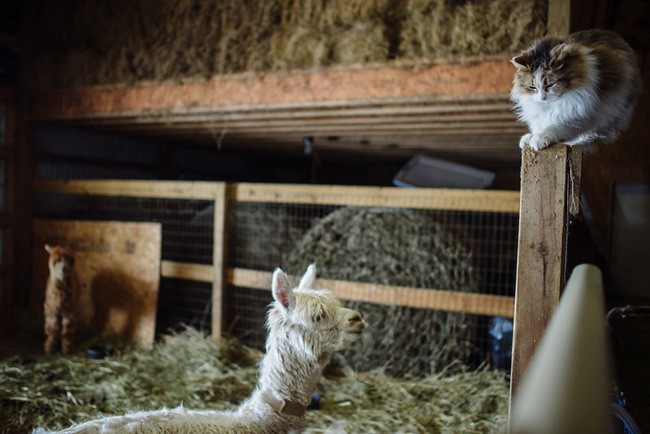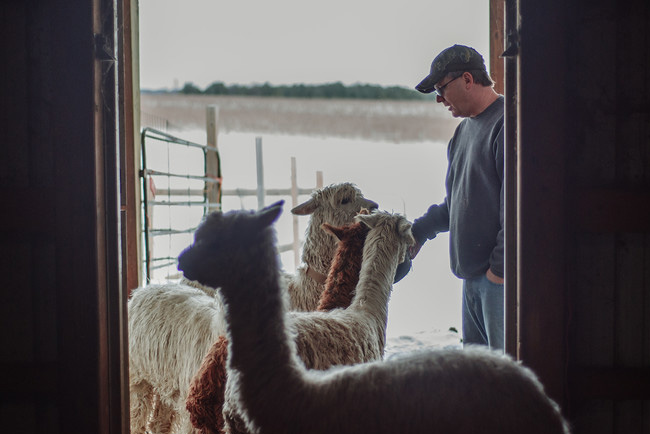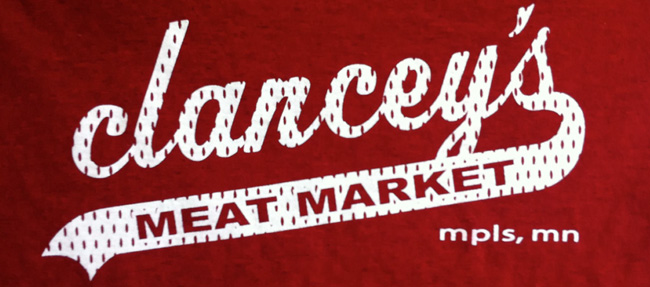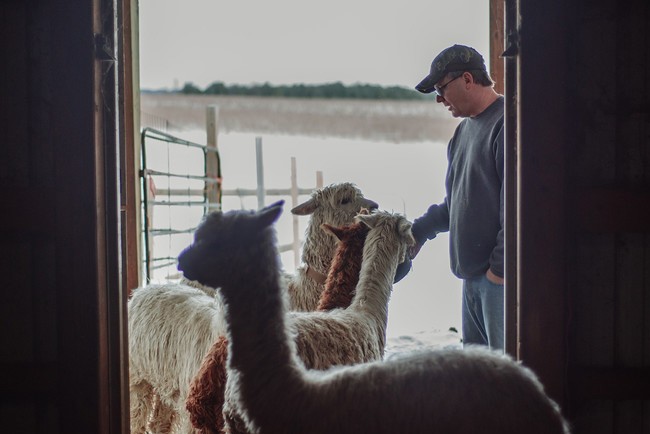
About the Farms in the Lens series: Much of what we write within these pages is focused on the restaurants of Minneapolis and St. Paul. But much of what we eat at those tables comes from farms around the state. With underwriting from Clancey’s Meats and Fish, we’ve set out to document a half dozen of these farms, focusing on the relationship between humans and animals. Check out our complete Farms in the Lens series, including: Wild Acres, Hidden Stream, Shepherd’s Way, Redhead Creamery, Twisted Suri Alpaca Ranch, and Paradox Farm.
In early 2011, Roger Welck saw a string of comments like this on the Facebook page for his Twisted Suri Alpaca Ranch:
“We don’t eat our alpacas here in the Civilized World.”
“This is simply appalling … ALPACAS ARE FIBER ANIMALS!”
“Greed caused this. Why not have the vet euthanize them instead of eat[ing] [al]paca burgers?”
“Do you slit their throats and hang them upside down to bleed out? I asked 10 times? Shoot them? Hit them with a hammar [sic]?”
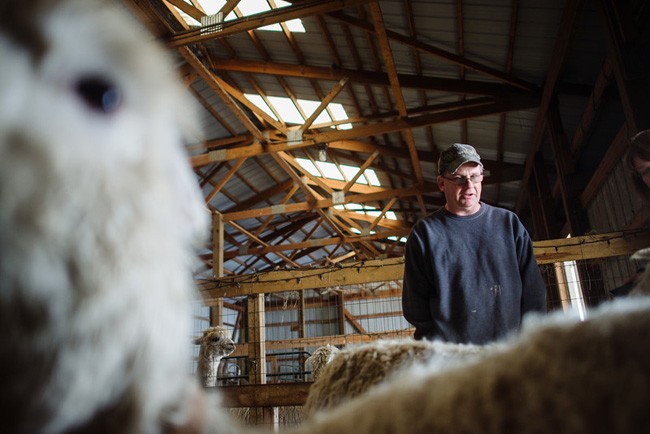
Welck had just come back from a meeting of the Upper Midwest Alpaca Association and word was spreading that he was developing a terminal market for alpacas. In other words, he was harvesting and processing them. In other words, he was eating them. And packaging their meat to sell to retailers and chefs.
Some of the commenters — all alpaca owners themselves — acted as if he were eating his own family members, Welck remembers. But a good number of others wrote some version of: “Thank you. It’s about time.”
Roger Welck got into alpaca farming for the same reasons that most other people do. Neither he nor his wife had a background in farming, but after 14 years in receiving at Frito-Lay in the Twin Cities, he was ready to leave city life behind, to move the kids out to the country, to set his own hours, and to do something more hands-on than the modern-day paper pushing that occupies most of us all day. As farm animals go, alpacas are famously adorable and even-tempered. Welck remembers that when it came time to decide which breed to focus on, he chose Suris over Huacayas in part because of how cute they look when they bound across a field. That was in 2007.

In Brooklyn Park, Welck had kept an award-winning yard and garden, and the original plan was for him to raise perennials for sale at the farm in Princeton, Minn., and keep the alpacas as a kind of tourist attraction, selling fiber, hats and mittens as a way of maintaining customer traffic year round. But, as alpacas tend to do, they had soon taken over his business and his heart.
By 2010, Welck had 80 alpacas in his fields and barns. And, like a lot of alpaca farmers around that time, he started doing the math.
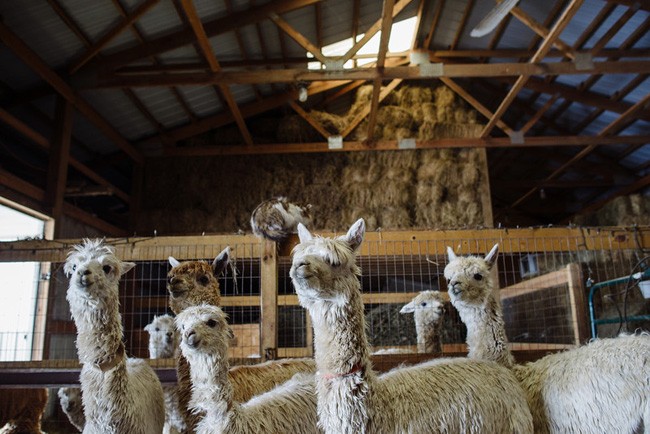
Welck spends about $125 a year to feed, house and care for each animal. (Farms that focus on breeding and showing spend more.) Each alpaca yields about 10 pounds of fleece, which wholesales at $2 to $3 a pound. The way most alpaca farmers make up the difference is through selling breeding stock: In 2004 top females were fetching a mean price of $26,000 at auction. That, of course, requires some other alpaca farmer who is willing to pay thousands of dollars for an animal that won’t make its weight in fleece but can be bred to sell crias (baby alpacas) to other farmers. And those farmers will also need to breed and sell the animals to cover their costs. Sustaining prices like that requires a never-ending stream of new farmers.
It starts to look a little like a pyramid scheme. It looks an awful lot like a bubble.
And, like most bubbles, it popped.
Today, you might still get as much as $10,000 for the highest-quality breeding stock, but an unremarkable male alpaca might fetch $50 or $100. Or nothing at all.

And that’s where Welck comes in. His company, Many Pastures, purchases alpacas from other farmers and processes the meat. Some of those farmers are getting out of the business altogether. Many can’t find a market for their male alpacas. Others are looking to cull their herds to improve their breeding and fiber stock. None of them is solely or even primarily in the meat business.
“You can never breed these animals for meat,” Welck says. It takes four or five years for an alpaca to fill out, so by the time an animal is ready for processing, a farmer has put at least $500 into it. When you’re getting about 50 pounds off each alpaca, that math is just as shaky as the purely fiber industry.
“What I tell people is you have to be very efficient with your fiber,” Welck says. “The terminal market is a way to get that animal off your property and get a little bit of money. You have to make money on fiber still. This will never be a meat industry.
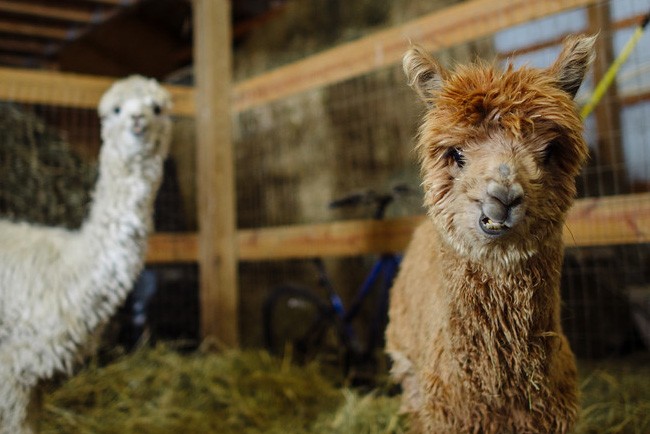
This will be a fiber-first industry with a terminal market on the back side. And that’s a huge thing for me.”
What Many Pastures does, essentially, is set a floor price for non-breeding stock alpacas, the bottom 10 percent of a herd, say, that aren’t making their weight in the fiber market and don’t have a value on the breeding market.
At the same time, he is building a nose-to-tail livestock industry from scratch. Alpacas were first brought to the United States in 1984 and have been used for a single purpose — fiber — ever since. Livestock industries that have been here since colonial times have naturally developed ways to get every penny possible out of every cow, sheep and pig, whether that’s for meat, leather, glue, pharmaceuticals, animal feed or something else.
Welck wants to do the same thing for alpacas. He turns the coarser and less profitable leg hair into boot insoles and felted dryer balls. He cuts the legs into shanks, smokes them and sells them for dog bones. He chops and freeze dries the offal for 100 percent natural dog treats. He tans the hides and is looking for a partner to turn them into high-end leather goods. Even the manure adds value: Welck keeps 400 pounds of red worms busy turning alpaca droppings into compost that he bags and sells.
Dog treats, dryer balls and compost all contribute to the bottom line, but it’s the exotic meat that will always attract attention to Many Pastures.

Welck, as far as he knows, was the first to get a nutritional label for alpaca meat (which the USDA doesn’t consider an “amenable meat,” so its regulation is a gray area, left to state agencies). “I’ve been saying this for five years,” he laughs, “and nobody’s every said, ‘No, I was the first.’”
Last year, Many Pastures processed about 200 animals, 80 percent of which were purchased from other farmers. This year, Welck plans to double that. Because he is buying from farmers who were culling unwanted animals, he faces a bit of a bubble himself: He is now buying farther and farther afield, working with farmers and processing plants around the country. But he has also developed relationships with about a dozen farms who plan to cull about 10 percent of their herds annually or biannually, providing a steady supply of meat animals.

An alpaca, it turns out, dresses out a lot like a deer. Many Pastures sells the backstrap — the most tender part — as steaks, and also markets the loins and packages of ground meat. Everything else gets turned into seasoned alpaca sticks (which taste a lot like Slim Jims), and coming soon, press-and-form jerky. You can often find Welck at co-ops — including The Wedge, Seward, Linden Hills, and East Side — handing out alpaca samples and chatting about what he calls “the other red meat.”
And, if you happen to work at Target’s headquarters on Nicollet Mall, or another workplace with a cafeteria run by Bon Appetit or Taher, you’ve probably seen alpaca lettuce cups on the menu.
How does it taste? Alpaca is ultra-lean, sweetish, and in some ways, a little like pork.
It makes a deliciously juicy medium-rare burger. Because it actually tastes meaty, unlike so much commercial chicken and beef, some people will compare it to buffalo and venison. But Welck disagrees.
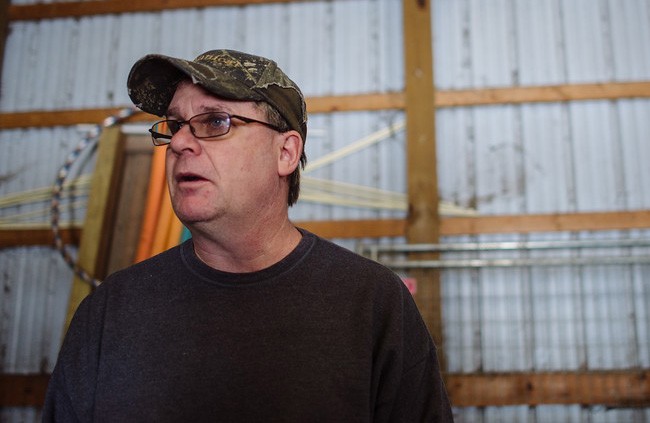
“I have a tough time with that because all of the animals we use are pasture-raised, hay-raised — none of them have a gamy taste,” he says. “I love the people who taste our meat and say, ‘God, that’s gamey.’ Frickin’, they eat hay and oats!” Game (and therefore gamey) animals spend their days foraging and bounding away from predators; alpacas, not so much.
Whether alpaca will catch on is hard to say. Food cultures are strong and the anthropological line between “food” and “not food,” doesn’t shift easily. (Do you get a craving for cuy? Me neither.) A lean, juicy, flavorful, sustainable burger will definitely win over some of the co-op crowd. But what about mainstream, non-foodie guys like Welck himself?
“Still, 98 percent of my meals are beef and pork, even though I have alpaca in my freezer,” Welck says. That’s what he was raised on. “Plus, I can’t afford to eat my own alpacas. But that’s another story.”
